Books
Books

Mudun – Short stories from the Arab world
Sultan Sooud Al Qassemi, Razmig Bedirian and 2 more
Published on the occasion of Mudun Short Story Prize, an international competition that pays tribute to cities around the Arab world which was launched by the Barjeel Art Foundation, Sharjah (UAE), in 2021, Mudun: Stories from Arab Cities brings together the 19 stories—10 in Arabic and nine in English—that were shortlisted for the prize, including the winning submissions.
Texts by Neetha Kurup, Soraya Morayef, Ashton Eleazer, Noora Alhashimi, Lynn Cheikh Moussa, Ramzi Maqdisi, Fatemah Raed Al Awadh, Barrak Alzaid, Bhoomika Ghaghada, Sami Raghad, Naima Abdul Wahab Abdullah, Diar Murshid, Wajdi Al Ahdal, Ben Addi, Nawaf Al Mazmi, Maryam Mirza, Laila Kubba, Ahmed Fouadeldin.

Salmon: A Red Herring
Salmon: A Red Herring questions what colours we expect in our "natural" environment. It asks us to examine how our perception of colour is changing as much as we are changing the planet. Adapted into the eponymous Turner Prize-nominated exhibition at Tate Britain, this book launched an international campaign against salmon farming.
In 2018, the artist/activist duo Cooking Sections heard of a sparrow that had turned bright pink on the Isle of Skye. So began an odyssey-like investigation into where it went, who was responsible, and what it signalled about its surrounding ecology. The pair spoke to fishermen in Mexico, where shrimp are turning grey, interviewed beekeepers in Brooklyn, who reported red-coloured honey, and investigated the Nornickel factory in Norilsk, Russia, where blue fog and black snow are industrial byproducts. Their findings are presented as a detective story for the era of environmentalism: a wildly inventive book and an exhibition at Tate Britain.
The book, Salmon: A Red Herring, shows how design can address the fragility of our food systems and how colour configures our economies. It is a visceral and visual examination of aesthetic manipulation, industrial farming, and environmental degradation, a seminal intervention in colour theory. In turn, Cooking Sections—the recently announced winners of the Harvard Wheelwright Prize—use it to launch a new global campaign against fish farming.
As COVID makes visible the fragility of our food systems and the need for an overhaul of environmental regulations, this work is now more relevant than ever. The publishers describe it as "Michael Pollan meets Gilbert and George" and Cooking Sections say it is "intended as a Ways of Seeing for the era of environmental reassessment".
Cooking Sections examines the systems that organise the world through food. Using site-responsive installation, performance and video, they explore the overlapping boundaries between art, architecture, ecology and geopolitics. Established in London in 2013 by Daniel Fernández Pascual (born in 1984) and Alon Schwabe (born in 1984), their practice uses food as a lens and a tool to observe landscapes in transformation.
Forewords by Bruno Latour, Hans Ulrich Obrist, Hannah Landecker, David Zilber.

Ever Gaia
James Lovelock, Hans Ulrich Obrist
The most accessible introduction to the life and work of James Lovelock, and a guide to address today's "polycrisis."
There is no creation of the future if we do not sustain, at root, an intuition for invention. No one understood this better than James Lovelock, the most significant scientific thinker since Charles Darwin.
Over the course of his career, Lovelock set the terms by which we've come to understand life—biologically, societally, poetically—in the twenty-first century. He helped NASA complete missions to Mars and the moon; he invented devices that revealed the presence of harmful chemicals in the Earth's atmosphere, inspiring Rachel Carson to write Silent Spring; and he formulated the Gaia hypothesis, the deceptively simple idea that our planet could be viewed as a single self-regulating organism—everything entangled, everything acting upon everything else.
In September 2015, Hans Ulrich Obrist traveled to Dorset to visit Lovelock at his seaside cottage, where they spent nine hours discussing garden cities, frozen hamsters, rising temperatures, tiny widgets, the Space Age, the birth of modern science, the agonies of institutions, and the future of humanity. Ever Gaia presents this conversation as a celebration of Lovelock, who died in 2022 at 103, alongside contributions from two future pioneers of Gaia: Daisy Hildyard and Precious Okoyomon. As another of Lovelock's heirs, Tim Lenton, writes in his afterword, this encounter was pivotal in Lovelock's late intellectual life and, at the start of 2023, provides a guide—by way of Lovelock's Gaian approach—to address today's "polycrisis."
Ever Gaia opens the second season of isolarii as a tribute not just to Lovelock but to the late Bruno Latour, who introduced the series when we launched it two years ago. The second volume of a trilogy that started with the release of The Archipelago Conversations in 2021, Ever Gaia is the most accessible introduction to the life and work of Lovelock, whose way of seeing—"perhaps his greatest legacy," Obrist writes—will continue to shape our world and our place within it for decades to come.
.jpg)
Under the Wings of the Valkyrie
An exploration of eroticism in extremism.
Published in Icelandic in 1994, Under the Wings of the Valkyrie is the work that established Sjón's literary career. Short and intense, the story unfolds through a letter from Icelandic architect Fridjón B. Fridriksson to his wife, revealing his lifelong obsession with German militant Gudrun Ensslin, of the Baader-Meinhof gang. He first glimpsed her on TV as a child and now Ensslin lingers in his dreams and has become the defining fixture of his psyche. To break free from Ensslin, and salvage his marriage, Fridjón resorts to drastic measures. Disturbing yet captivating, Under the Wings of the Valkyrie blurs the lines between passion and madness, fantasy and reality.
Sjón (Sigurjón Birgir Sigurðsson, born 1962 in Reykjavik) is a celebrated novelist, poet, and lyricist, who has become a central figure in Icelandic culture. Junot Diaz hailed him as "the trickster who makes the world" and the late, great A.S. Byatt regarded him as "a Magus of the North." He is known also for his collaborations with singer Björk, receiving an Oscar nomination for lyrics to Lars von Trier's Dancer in the Dark, and his screenplays for critically acclaimed films The Northman and Lamb. His works have been translated into 30 languages.
Translated from the Icelandic by Brian Fitzgibbon.
.jpg)
Charismatic Spirals
Charismatic Spirals is for an America circa 2024, where poetry—the art of developing new means of speaking—has never been of such artistic, technological and political consequences.
An archetypal outsider, Will Alexander released his first poetry collection aged forty-four while working at the Los Angeles Lakers' ticket office. Three decades on, he has ascended to the legendary status of the city's great living surrealist, existing, as Eliot Weinberger wrote, in a state of "imaginal hyperdrive," with forty such collections to his name.
Operating at the edge of language, Alexander deploys words in a way that feels prophetic—human psyches synthesize with technological artifacts; atoms and archetypes collide; bodies are vacated, voices are newly incarnated. His America—like Glissant's—is multinational and—like Coover and Spiegelman's—multivalent and symbolically unstable. That is to say, he belongs to an America circa 2024, where poetry—the art of developing new means of speaking—has never been of such artistic, technological, and political consequence.
In doing so, Alexander draws from a vast array of influences, from luminaries like Aimé Césaire, Bob Kaufman, Andre Breton, Antonin Artaud, and Philip Lamantia, to holistic visions such as Sri Aurobindo's Integral Yoga, the Mayan numerical system, and Cheikh Anta Diop's perspectives on ancient Egypt. In a preview of Charismatic Spirals in the New York Times, Anne Boyer captured the essence of his work: "visionary poetry [that] achieves its effect through sound, not image...Cadence [that] can shatter us, set the world ablaze."
Read it syllabically, surf it quickly—there is no single way to approach this work.
Will Alexander (born 1948 in Los Angeles) is an African-American artist, philosopher, poet, novelist, essayist and pianist.

Imperfect Solidarities
Art, empathy and political solidarity.
Can empathy deliver political change? Does art that elicits emotional identification with others take us where we need to go? In Imperfect Solidarities, writer and art historian Aruna D'Souza offers observations pulled from current events as well as contemporary art that suggest that a feeling of understanding or closeness based on emotion is an imperfect ground for solidarity. Empathy—and its correlate, love—is a distraction from the hard work that needs to be done to achieve justice. Rather, D'Souza contends, we need to imagine a form of political solidarity that is not based on empathy, but on the much more difficult obligation of care. When we can respect the unknowability of the other and still care for and with them, without translating ourselves into their terms, perhaps we will fare better at building political bridges.
Aruna D'Souza is a writer and critic based in New York. She is a regular contributor to The New York Times and 4Columns.org, where she is a member of the editorial advisory board. Her writing has also appeared in The Wall Street Journal, CNN.com, Bookforum, Frieze, Momus, and Art in America, among other places. Her book, Whitewalling: Art, Race, and Protest in 3 Acts (Badlands Unlimited), was named one of the best art books of 2018 by The New York Times. She is the recipient of the 2021 Rabkin Prize for art journalism and a 2019 Andy Warhol Foundation Art Writers Grant.
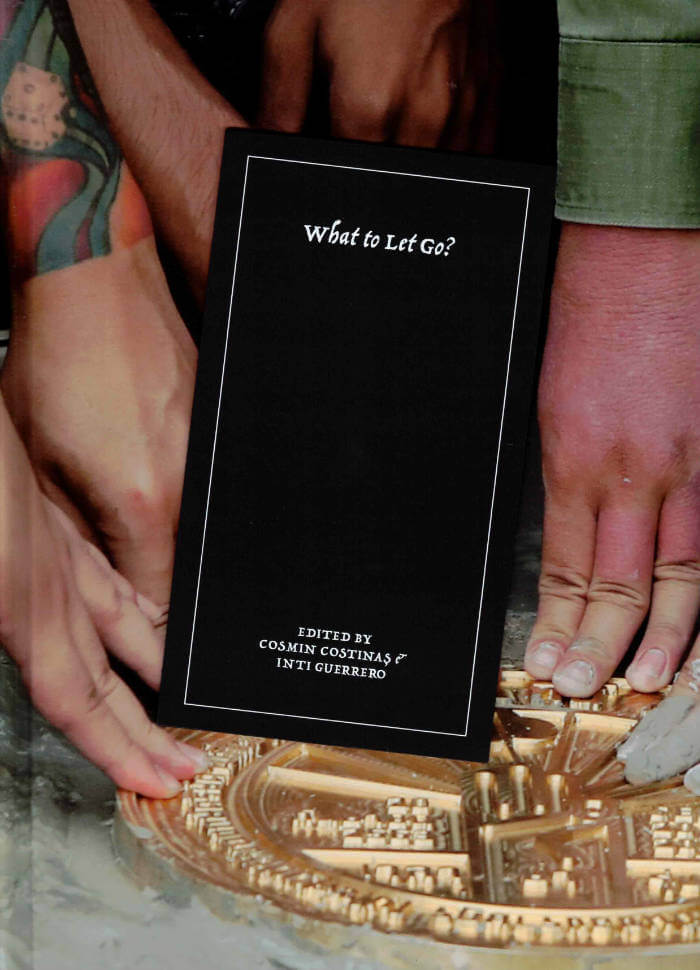
What to let go?
Cosmin Costinaş, Inti Guerrero
What gets counted within the category of heritage, and who gets to do the counting?
This book contributes to discussions about what counts as heritage now, who gets to do the counting, and broader related issues around the subject of cultural sovereignty. It unpacks historical narratives and political memories linked with objects, sites, and ceremonies that have been lost, looted, restituted, repatriated, revived, or reinvented. Through its diverse line-up of discourse, poetry, and original artistic contributions, it weaves together subjects and geographies that are not usually part of the same conversation —from plundered cultural belongings held in colonial collections, to processes of renaming or removing symbols of past eras— and considers how they relate in the context of recent social upheavals and political processes across continents.
In our era of dangerous revisionism, when history has become a battlefield for both the left and the right, we are asking: How can art reconfigure our collective foundational myths? And of what should we let go on the journey towards figuring it out?
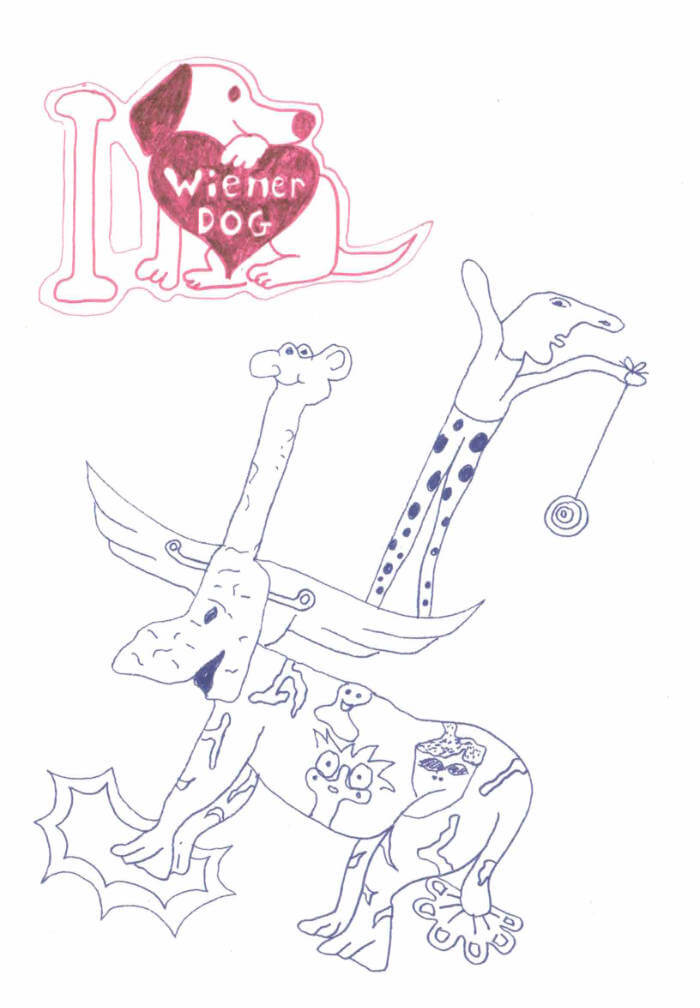
I Love Wiener Dog
A series of “Bad Paintings” by the Geneva-based artist.
White noise escapes from the 3rd floor of an opulent building located in the Eaux-Vives district. In an apartment, converted into a laboratory, hum a whole bunch of complicated machines linked together by a tangle of multicolored electrical wires. In the middle of all this mess, wrapped in transparent plastic sheets, a new experience will take place in a few moments.
Indeed, for the first time in history, a team of researchers will be able to precisely decode the creative process of an artist. Plunged into an artificial coma, the Genevan painter Josse Bailly wears a sort of motorcycle helmet, from which colorful cables spring. At the end of the test, Bailly's abundant pictorial practice will no longer have any secrets for the scientists present. The mechanism of his artistic frenzy, this true fury to paint, will be translated in an intelligible and logical manner.
Suddenly, a crackling sound is heard. Eyes rolling back, Bailly suddenly sits up square on the massage table transformed into an electric chair. Foaming at the mouth, he chants a series of names of old rock groups from the 70s. Sparks come out of the artist's blackened nostrils. His head looks like it's going to explode any minute. The screens light up in the smoke. Words scroll continuously on the monitors: "The beanbag chair", "Harvard beets", "I love wiener dog".
The pellets go off, putting an end to the strange scene which is more reminiscent of a planned execution than a scientific study. An expression of perplexity freezes on the stunned faces of the team of researchers. In a heavy silence where there is a smell of scorching, a young assistant risks slipping in a confused voice: "I think he likes to illustrate wiener dogs because he finds them cute and it's cool to draw them."

The Significance and Relevance of Early Modern Indian Painters to the Contemporary Indian Art
The Significance and Relevance of Early Modern Indian Painters to the Contemporary Indian Art, written in 1971, reevaluates the legacies of painting inherited by the artist Nilima Sheikh.
Drifting between two inadequate models, one an import of British Colonialism, and another desperate for an identification as "Indian", the artist engages with the works of Raja Ravi Varma, Abanindranath Tagore, Amrita Sher-Gil, Nandalal Bose, and Jamini Roy, as well as the critical and art historical writing surrounding these practices, to offer a revaluation of these legacies and a possible way forward—one that she would go on to articulate in her own decades-long engagement with painting.
Published here for the first time, The Significance and Relevance of Early Modern Indian Painters to the Contemporary Indian Art was written as part of Nilima Sheikh's Master's in Painting at the Faculty of Fine Arts, Maharaja Sayajirao University of Baroda. The complete facsimile of this dissertation is accompanied by a recent interview with the artist by Nihaal Faizal and Sarasija Subramanian.

Itinéraires Fantômes (box set)
Hélène Cixous, Alexandra Grant
Itinéraires Fantômes is an oracle deck created by Alexandra Grant with Hélène Cixous in celebration of H. Cixous' work.
The Itinéraires Fantômes deck consists of 72 cards in six categories: animots, creatures, and entities that include Those from Below, Those from Above, Those Who Fly/Steal, who travel via Portals, manipulate Messages and Symbols, and have Superpowers. The cards are accompanied by a booklet in English and French.
The images on these cards come from family, friends, and artists who have been inspired by Hélène Cixous' writing. Artists include: Adel Abdessemed, Pierre Alechinsky, Sara Barker, Gabrielle Berger, Louise Bourgeois, Leonardo Bravo, Maria Bussmann, Sarah Cain, Lewis Carroll, Bertrand Charneau, Maria Chevska, Michael Kennedy Costa, Laura Darbutaitė, Tacita Dean, Edgar Fabián Frías, Jeffrey Gibson, Francisco Goya, Alexandra Grant, Mathew Hale, Simon Hantaï, Johanna Hedva, Roni Horn, Victor Hugo, Hanna Hur, Franz Kafka, YeRin Kim, Lynn Marie Kirby, Jean-Jacques Lemêtre, Colin Lemoine, Laure Prouvost, Elsa Prudent, Addy Rabinovitch, Keanu Reeves, Cindy Rehm, Saranya Siegel-Berger, Shinique Smith, Nancy Spero, Luc Tuymans, Unyimeabasi Udoh, Roger Viollet, Anna Winger.

Instructions for The Lovers
A taut, tender collection of poems woven with sadness and loss dealing with aging, attachments, and the precarity of life.
“Dawn Lundy Martin’s poems read like a real-time excavation of what poetry can and can’t do,” writes Maggie Nelson. In Instructions for The Lovers, her most stripped down, direct work to date, Martin creates a poetic field dense with thought, image, and sound as she reflects on her relationship with her mother, experiences of queer polyamory, lesbian sex, and the racist conditions within the dying American university system. With rigorously embodied vulnerability and virtuosity, Martin constructs moments of pleasure, humor, and sexiness woven with grief—a tender body to live in.

Trash
Trash interweaves the voices of three women with lived connections to the municipal garbage dump of Ciudad Juárez, Mexico.
Aguilar Zéleny's Trash shows the complexities of survival and joy, love and violence for three women: a teenager abandoned by her guardian at the dump, a scientist doing research on the residents of the dump, and a transwoman living nearby who is the matriarch of a group of sex workers.
Each one of the characters navigates family, abandonment, power, jealousy, greed, and multiple taboos around sexuality and gender violence. Their stories are linked by geography and by ideas of waste and abandonment.
As Aguilar Zéleny explores these territories in her book, she asks crucial questions: who is seen as disposable and why? How do women find their own means of survival and joy in the midst of a perilous sociopolitical context? What does it mean to live a life in a time of austerity and extreme violence? Trash is a critical intervention in Mexican literature.
Translated by J.D. Pluecker
Lambda Literary Award Finalist for Transgender Fiction

GLEAN - Issue 4 (ENG edition)
Apparatus 22, Dak’Art, Tarek Atoui, Sirah Foighel Brutmann & Eitan Efrat, Yoko Ono, Pei-Hsuan Wang, Anna Zemánková, Sarah Smolders, Miranda July, Britta Marakatt-Labba, Ignacio Barrios

an A to Z of Indexing / Organising / Cataloguing BFTK for Two Voices + a Triumvirate Announcement for Editions A, B, C
The reading score for the presentation at rile*books on Sunday June 23, an A to Z of Indexing / Organising / Cataloguing BFTK for Two Voices.

tendentious | neo-semantics
Transcribed from previously unpublished text-sound transcripts, the edition also brings together selections from Greenham’s aphorisms and 50 words-stories and a fragmentary pre / post-script from documents in the Lily Greenham Archive, and is accompanied by an epistolary insert from sound poet Larry Wendt.
Greenham was an artist / composer / writer / performer and inventor of the term ‘lingual music’. This launch is part of a two-day symposium that coincides with the exhibition ‘Lily Greenham: An Art of Living’ at the Badischer Kunstverein, the first large-scale retrospective of her work.

Broken Villas
Written in response to three “physical” photographs, ‘Broken Villas’ contains and considers how a vessel might clasp tightly to known volumetric identities, but also loom with a set of accentuated clues towards otherness: the excavated seams in the earth and what we fill those holes with, imaginary or otherwise; the glacial erraticism of the boulder; the queer crimping of a hotel pillowcase; the modes via which objects are housed as display, but also packaged away, with sorrow, with fear, with erotism etc.

Working Through Objects
The text by Hiller navigates the boundaries between art, anthropology and psychoanalysis in relation to her installation at the Freud Museum in 1994 titled At the Freud Museum. Accompanying images included throughout from Book Works UK archive, the commissioner of the artwork and talks that this text is edited from.
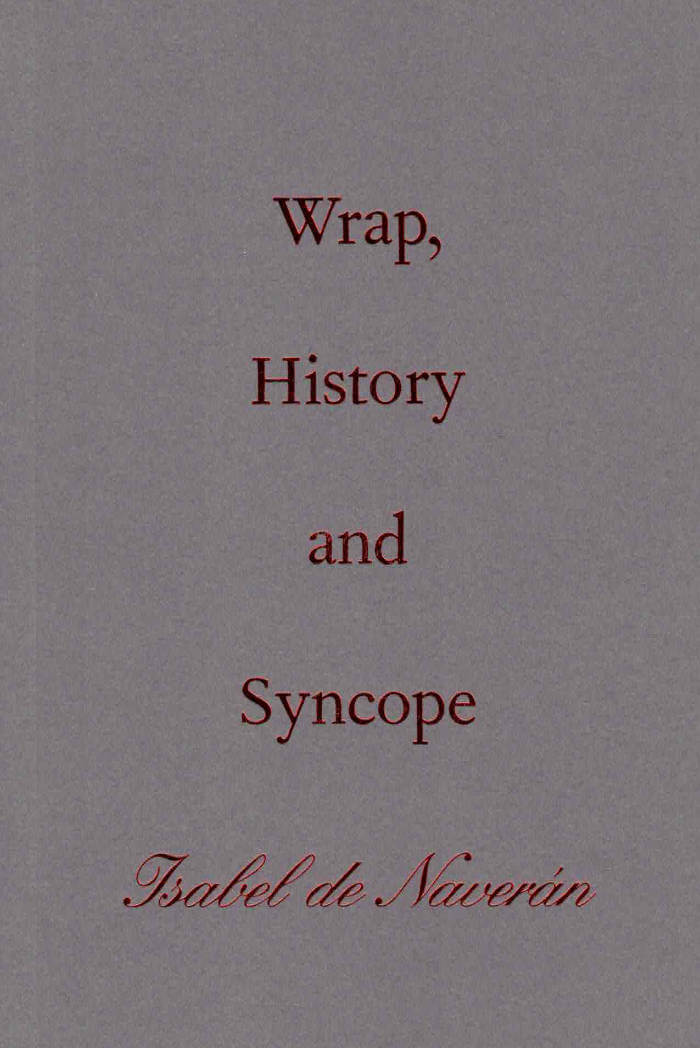
Wrap, History and Syncope
18 July 1936, Bayonne. After hearing the news of the Fascist uprising, the Spanish dancer and bailaora Antonia Mercé y Luque, known as La Argentina, suffers a syncope and dies in fateful synchrony with the Second Republic. History, and the artist’s body, have been seized and broken by the event.
In close dialogue with images and historical documents, Isabel de Naverán pursues the reverberations of that shock and how it resonates with collective pain and artistic translations (by Federico García Lorca, Gertrude Stein, Kazuo Ohno and others). How does history affect and move through bodies? How do living bodies carry and pass on cultural legacy and collective memory? What do these complex movements reveal about the present? Wrap, History and Syncope is an affective journey that invites the reader into tracing and revisiting other bodies, to ultimately dance their difference and multiplicity for oneself.
Isabel de Naverán is a writer and researcher. Concern with the passage and use of time is the backbone of her work, which focuses on bodily transmission and the examination of the concept of historical time by way of ephemeral and fugitive practices. She holds a PhD in art from the University of the Basque Country.
Translation from Spanish: Toni Crabb
Graphic design: Michaël Bussaer
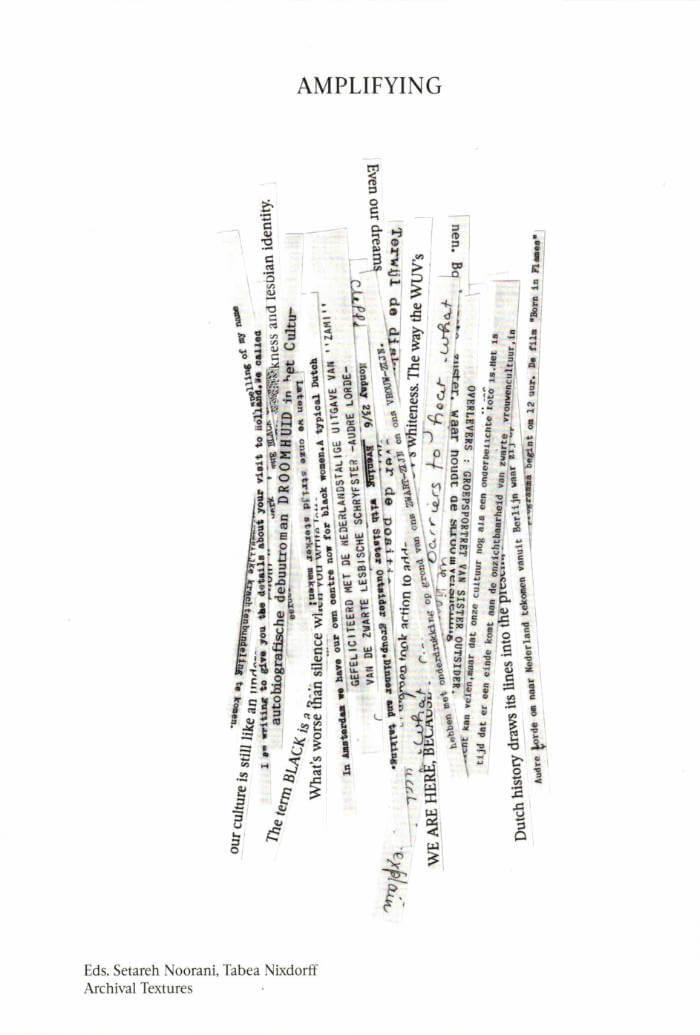
Archival Textures - Amplifying
Setareh Noorani, Tabea Nixdorff
The book Amplifying brings together written manifestations that trace the beginnings of Black feminism in the Netherlands. Amplifying means giving credit to, mentioning, over and over, and supporting the circulation of sources and authors that are formative for our thinking and practices. In the early 1980s, the political term “black” (zwart in Dutch) was introduced in the Netherlands to build alliances between women from different diasporic communities, who were faced with racism in their everyday lives.
Archival materials featured in this book include the original manuscript of the essay “Survivors: Portrait of the Group Sister Outsider” (1984), written by Gloria Wekker in collaboration with the Black lesbian literary group Sister Outsider, the seminal speech Statement of the Black Women’s Group (1983) by Julia da Lima, a contextualizing interview with Tineke E. Jansen and Mo Salomon (1984), excerpts from the book launch of Philomena Essed’s Everyday Racism (1984), and short texts authored by other Black feminist groups in the Netherlands, such as Zwarte Vrouwen & Racisme, Flamboyant, Ashanti, and Groep Zwarte Vrouwen Nijmegen.

Archival Textures - Posting
Carolina Valente Pinto, Tabea Nixdorff
The book Posting brings together a selection of feminist posters from Dutch archives to reflect on posting as an activist strategy, holding the potential to create counter-publics to mainstream culture and to fight against the erasure, exoticization, or tokenism of bodies and experiences that deviate from normative preconceptions.
As is the case for many professions, in the history of Dutch graphic design the absence of women, non-binary, queer, Black designers is striking. This doesn’t only point back to systematic processes of exclusion in the first place, but also to the biases at play regarding whose work is remembered and archived. While efforts have been made to add forgotten names to the existing canon, the many posters, flyers and other printed matter shelved in queer and feminist archives remind us to question the notion of single authorship altogether and instead study graphic design as a decisively collaborative and transdisciplinary practice, which is especially true for community-led and volunteer-based projects.
The posters featured in this book point to this rich landscape of feminist organizing, and were found at the International Institute of Social History and the International Archive for the Women’s Movement (IAV-Atria) in Amsterdam.
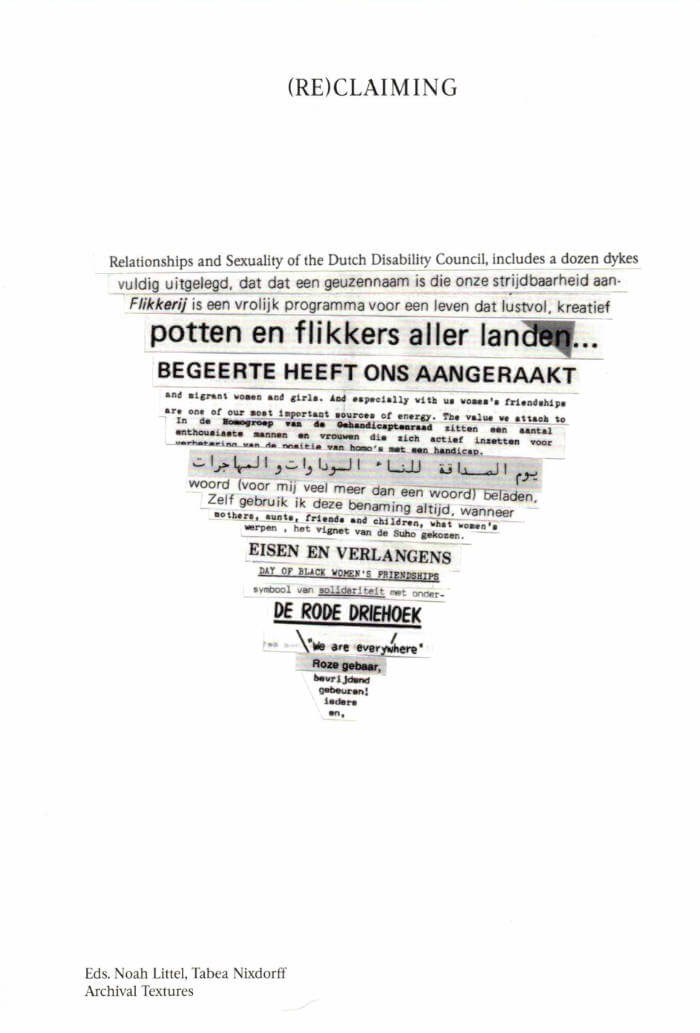
Archival Textures - (Re)claiming
The book (Re)claiming presents ways in which various queer and feminist communities and initiatives in the Netherlands have (re)claimed the triangle—along with other symbols, words and stories—and in doing so take up an empowering position in a hostile society.
Besides a collection of buttons, archival materials featured in this book include short statements and flyers by queer groups such as SUHO, Sjalhomo, Roze Front, Roze Driehoek, Roze Gebaar, Van Doofpot tot Mankepoot, Interpot/ILIS, Lesbisch Archief Amsterdam, Strange Fruit Vrouwen and Groep Zwarte Vrouwen Nijmegen, as well as a text by Karin Daan, the designer of the Homomonument in Amsterdam. With this selection, this book brings together queer, trans, crip, feminist, Jewish and Black perspectives on (re)claiming as an activist strategy.
Most of these materials were researched at IHLIA LGBTI Heritage in Amsterdam, with additions found at the International Institute of Social History and the International Archive for the Women’s Movement (IAV-Atria) in Amsterdam, and LAN Lesbisch Archief Nijmegen.

Christopher D’Arcangelo
Despite having been active for only four years before passing away at the young age of twenty-four, Christopher D’Arcangelo (1955–1979) is a key, though lesser-known, figure of 1970s Institutional Critique in New York City. Even generations later, D’Arcangelo’s singular approach remains wholly unique in its radicality and generosity. This first estate-approved monograph illuminates his momentous practice after many decades of limited access to the materials surrounding it.
The publication also includes new contributions from figures who have punctuated D’Arcangelo’s practice—such as Peter Nadin, Daniel Buren, Louise Lawler and Janelle Reiring—as well as photographic contributions by artist Heji Shin and a new text by Nicholas Martin.

First Drafts #2: Canonically Speaking
Canonically Speaking is the second title to appear on the First Drafts imprint, a zigzag in Kunstverein Publishing’s output that’s dedicated to publishing completed manuscripts that would otherwise, for an array of reasons, not see the light of day in this rough early form.
Central to Canonically Speaking is the idea that (female) life is an inherently surrealist experience. In this spirit, the ‘absurd’ is embraced as a means to speak out on themes such as self-image, spirituality, mental health and work. While slipping between poetry, comprehensive list-making, knock knock jokes and intertextual references, forms of recital and misinterpretation often take place, whereby characters quote and repeat sentences and words from a large variety of sources, jumping from the health benefits of whale blubber to court transcripts of Bill Clinton's impeachment to the plasma that is released when microwaving two grapes side by side.

The Wastes
After the death of her mother a woman decides to visit a familiar strip of rural upland, darkly identified on the South Pennines Ordnance Survey map as: The Waste. As she moves between trains, shunted by public encounters and haunted by past bar jobs, damp bedsits and a press shot of Vanessa Redgrave smoking in the bath, found slipped between the pages of her mother’s diary, the threshold between her past, present and future self dissolves. Fringe images she has neither designed nor authored begin to steer her toward grid reference 3499, where underfoot the semi-solid mud turns with worms and ants.
The Wastes is published as part of Arrhythmia, a series curated for Book Works by Katrina Palmer.
Roy Claire Potter works between performance and experimental art writing with recent work commissioned by Tate Britain and Tate Publishing, Reduced Listening for BBC Radio 3, Cafe OTO and Counterflows, and Primary. They are Senior Lecturer in Fine Art at Liverpool John Moores University.
Katrina Palmer is an artist and writer, living in London. She is the author of The Dark Object (2010), The Fabricators Tale (2014), End Matter (2015) and Black Slit (2023), all published by Book Works. She has exhibited extensively, including with an Artangel Open commission (2015), at Henry Moore Institute (2015-16), Yorkshire Sculpture Park (2018), and with Estuary and Waterfronts (2021). She received the Paul Hamlyn Foundation Award for Artists (2014).